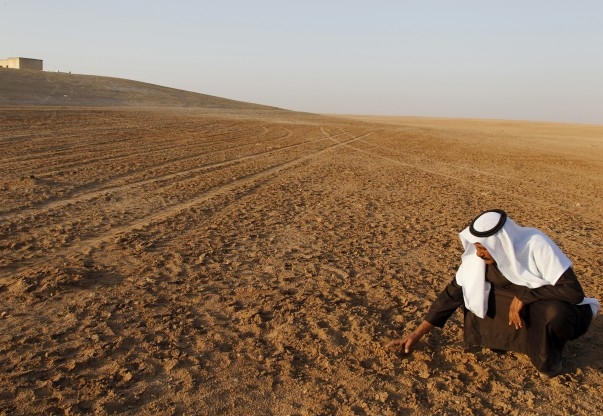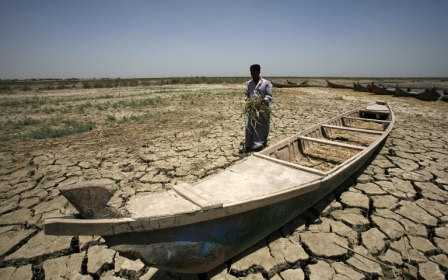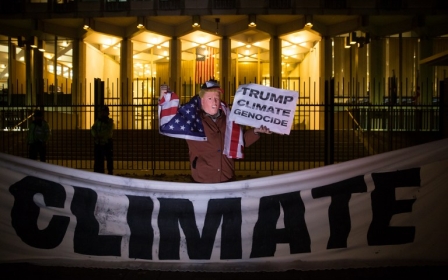Climate change may make Middle East and North Africa uninhabitable

It doesn’t take a rocket scientist to know that the Middle East gets hot in the summer, but scientists and studies warn that climate change may make living there much harder. They say the entire Middle East and North Africa (MENA) region is susceptible to some of the more severe consequences of global warming, including lethal heat waves, extensive drought and rising sea levels.
Dr Benjamin Cook, a NASA scientist at the Goddard Institute for Space Studies, told Middle East Eye that the region is particularly vulnerable to climate change.
“The MENA region and the Mediterranean can expect reduced rainfall, increased intensity and occurrence of droughts, and much more severe heat extremes,” he said.
“The whole region is already highly sensitive to drought because of the limited water resources, and this area is a place where we really expect the drought-related impacts of climate change to be particularly important. Sea level rise is likely to have a big impact anywhere along the coast, especially on cities and settlements that are right at sea level,” he added.
Cook warned that “the further we move into the future, and the stronger the warming, the clearer and stronger all of these impacts will be”.
Global food security in peril
On Monday, the think-tank Chatham House published a report on how climate change imperils global food security by pressuring a small number of Middle East “chokepoints” – or critical trade route locations.
These chokepoints – the Suez Canal, Turkish Straits, Strait of Hormuz and Strait of Bab al-Mandbab – all provide major shipping ports for global food markets.
“Climate change will further widen the gap between food surpluses in centres of supply and deficits in centres of demand, spurring the movement of larger volumes of food around the world,” it read.
This area is a place where we really expect the drought-related impacts of climate change to be particularly important
- Benjamin Cook, NASA scientist
If climate change disrupts these ports through increased frequency of severe storms and rising sea levels and extreme heat waves, then global food prices are likely to spike and vulnerable areas, such as Yemen, will suffer from supply shortages.
The study said the MENA region is particularly prone to the effects of climate change. The region is the most “food import-dependent in the world” and more than one-third of all basic foods travel through one of those chokepoints.
“MENA countries rely on grain exports from the Black Sea, transported via Russian and Ukrainian railways and ports and on through the Turkish Straits,” the study said.
If one of those areas shuts down for whatever reason, it said, no alternative routes exist, resulting in an imbalance of “market access for many countries in the region”.
“Historical links between food insecurity and political/social instability make the region’s extreme exposure to chokepoints risk a particular cause for concern,” it added.
Countries along the Strait of Hormuz, a gateway into the Gulf, are particularly vulnerable, the study said. Kuwait, Qatar and the United Arab Emirates rely on it for more than 80 percent of their wheat imports.
Deadly heat waves
The Gulf is also particularly vulnerable to an increased frequency of lethal heat waves as a result of climate change.
A team of scientists at MIT published a study in 2015 saying for the first time that global warming increases the likelihood of deadly heat waves in the coming decades along the Gulf.
Dr Elfatih Eltahir, an MIT professor of civil and environmental engineering and one of the authors of the study, told Middle East Eye that through climate simulation models, scientists found that several areas in the Gulf could become inhabitable in the coming decades.
"We studied predictions of temperature conditions towards the end of the century," he said.
"Instead of using regular temperature that everyone is familiar with, we used a variable called ‘wet-bulb temperature’, which is a temperature that measures a combination of temperature and humidity. And when we look at things from the lens of that variable we find the Persian Gulf area during summer reaches very high values – values higher than any other region in the world."
Eltahir added that projections show temperatures could reach dangerous levels for human survivability.
He emphasised that this threshold is 35 degrees centigrade, adding that it only applies for the most able-bodied people. This means that people with health problems, children and the elderly have a lower threshold for survivability.
The wet-bulb temperature threshold means that people are not able to cool off by sweat alone, adding that people's survivability is in peril when they are outside for about six hours in those conditions.
Simply put, they found out that the lethal threshold is when the normal temperature reaches 46 degrees at 50 percent humidity.
“The Gulf is likely to reach that threshold before any other region on Earth,” Eltahir said.
In July 2015, Bandar Mahshahr, Iran - a town on the Gulf coast - went way above that threshold at 46 degrees plus 90 percent humidity, but only for a few minutes.
"If you go to Doha in the summer, what really bothers you is more than the heat, but the fact that it is hot and humid," Eltahir told Middle East Eye. "With the way the winds blow from the north, in our scenarios, places like Dubai, Abu Dhabi and Doha are particularly susceptible to these lethal heat waves, unlike other Gulf regions, such as Kuwait and southern Iraq."
But he stressed that those scenarios, even under a business-as-usual model, are "very rare". He said that by the end of century, the Gulf will experience that kind of deadly heat every decade or so.
Regardless, he said that that because of climate change, this occurrence is now within the realm of possibilities.
"It is a very extreme condition, we hope that it doesn’t happen and we hope that climate change is taken very seriously, but models are showing that has become a possibility," Eltahir added.
While climate change remains a hotly debated political topic for lawmakers and policy analysts, scientists say that by studying MENA countries, they have “high confidence” that climate change is taking place.
“The MENA region is a place where we have particularly high confidence in some of the impacts of climate change, specifically extreme heat and drought. So in that regard, these aspects of climate change may represent the most important challenges facing the region,” Cook told Middle East Eye.
New MEE newsletter: Jerusalem Dispatch
Sign up to get the latest insights and analysis on Israel-Palestine, alongside Turkey Unpacked and other MEE newsletters
Middle East Eye delivers independent and unrivalled coverage and analysis of the Middle East, North Africa and beyond. To learn more about republishing this content and the associated fees, please fill out this form. More about MEE can be found here.




